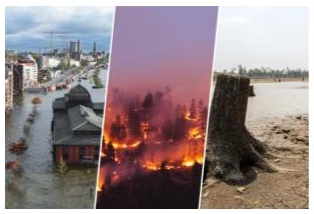- Burning fossil fuels
- Cutting down forests
- Farming livestock
These are increasingly influencing the climate and the earth’s temperature.
This adds enormous amounts of greenhouse gases to those naturally occurring in the atmosphere, increasing the greenhouse effect and global warming.
Global warming
2011-2020 was the warmest decade recorded, with global average temperature reaching 1.1°C above pre-industrial levels in 2019. Human-induced global warming is presently increasing at a rate of 0.2°C per decade.
An increase of 2°C compared to the temperature in pre-industrial times is associated with serious negative impacts on to the natural environment and human health and wellbeing, including a much higher risk that dangerous and possibly catastrophic changes in the global environment will occur.
For this reason, the international community has recognised the need to keep warming well below 2°C and pursue efforts to limit it to 1.5°C.
 Greenhouse gases
Greenhouse gases
The main driver of climate change is the greenhouse effect. Some gases in the Earth’s atmosphere act a bit like the glass in a greenhouse, trapping the sun’s heat and stopping it from leaking back into space and causing global warming.
Many of these greenhouse gases occur naturally, but human activities are increasing the concentrations of some of them in the atmosphere, in particular:
- carbon dioxide (CO2)
- methane
- nitrous oxide
- fluorinated gases
CO2 produced by human activities is the largest contributor to global warming. By 2020, its concentration in the atmosphere had risen to 48% above its pre-industrial level (before 1750).
Other greenhouse gases are emitted by human activities in smaller quantities. Methane is a more powerful greenhouse gas than CO2, but has a shorter atmospheric lifetime. Nitrous oxide, like CO2, is a long-lived greenhouse gas that accumulates in the atmosphere over decades to centuries. Non-greenhouse gas pollutants, including aerosols like soot, have different warming and cooling effects and are also associated with other issues such as poor air quality.
Natural causes, such as changes in solar radiation or volcanic activity are estimated to have contributed less than plus or minus 0.1°C to total warming between 1890 and 2010.
Consequences of climate change
Climate change affects all regions around the world. Polar ice shields are melting and the sea is rising. In some regions, extreme weather events and rainfall are becoming more common while others are experiencing more extreme heat waves and droughts. We need climate action now, or these impacts will only intensify.
Climate change is a very serious threat, and its consequences impact many different aspects of our lives. Below, you can find a list of climate change’s main consequences.
 Natural consequences
Natural consequences
What are the consequences of climate change for the natural world?
- High temperatures
- Drought and wildfires
- Availability of fresh water
- Floods
- Sea-level rise and coastal areas
 Biodiversity
Biodiversity- Soils
- Inland water
- Marine environment
Social threats
What social threats does climate change bring upon us?
- Health
- Vulnerable population
- Employment
- Education
 Threats to business
Threats to business
How does climate change represent a threat to business?
- Infrastructure and buildings
- Energy
- Agriculture and forestry
- Insurance
- Tourism
- Cross-cutting issues for businesses
 Territorial threats
Territorial threats
How are different areas affected by climate change?
- The Arctic
- Northern Europe
- North-western Europe
- Central and eastern Europe
- Mediterranean region
- Cities and urban areas
- Mountain areas
As you can see, climate change is a serious matter and it affects us all. This can be overwhelming.
SOLAR ENERGY IN INDIA
Context: G20 leaders agreed to triple the renewable energy capacity worldwide by 2030 and admitted the need to phase-down coal power.
India’s Intended Nationally Determined Contributions (INDCs) target to achieve about 40 percent cumulative electric power installed capacity from non-fossil fuel-based energy resources and to reduce the emission intensity of its GDP by 33 to 35 percent from 2005 level by 2030. Solar is the most secure of all sources due to its abundant availability and is expected to be the main driving force in India’s vision for transformation.
SOLAR ENERGY
- Theoretically, a small fraction of the total incident solar energy, if captured effectively, can meet the entire country’s power requirements. About 5,000 trillion kWh per year energy is incident over India’s land area.
- Solar energy can be used mainly in three ways:
-
-
- direct conversion of sunlight into electricity through PV cells
- concentrating solar power
- solar thermal collectors
-
- Advantages
-
-
- ability to generate power on a distributed basis
- enables rapid capacity addition with short lead time
- off-grid decentralization and low-temperature applications benefits rural areas
-
- social and economic benefits
-
-
- reduction in drudgery among rural women and girls engaged in the collection of fuel wood from long distances
- reduced cooking in smoky kitchens
- minimization of the risks of contracting lung and eye ailments
- employment generation at village level
- improvement in the standard of living
-

National Solar Mission (NSM)
Objective: to establish India as a global leader in solar energy by creating the policy conditions for solar technology diffusion across the country as quickly as possible
Period: launched on 11th January, 2010.
Feature:
- promote ecological sustainable growth while addressing India’s energy security challenges.
- a major contribution by India to the global effort to meet the challenges of climate change.
- targets installing 100 GW grid-connected solar power plants by the year 2022.
Development of Solar Parks and Ultra Mega Solar Power Projects
Objective: to facilitate the solar project developers to set up projects expeditiously.
Period: 2014-15 to 2023-24
Features:
- Makes setting up of solar projects hassle free for developers within the solar park – Difficulties faced by individual projects: huge cost for setting up infrastructure, higher project cost per MW and higher transmission losses.
- proposed to set up at least 25 Solar Parks and Ultra Mega Solar Power Projects targeting 20,000 MW of solar power installed capacity within a span of 5 years
- envisages supporting the States/UTs in setting up solar parks at various locations in the country with a view to create required infrastructure for setting up of solar power projects.
- The capacity of the solar parks shall be 500 MW and above. However, smaller parks are also considered where contiguous land may be difficult to acquire
Grid Connected Solar Rooftop Programme
Objective: To achieve a cumulative installed capacity of 40,000 MW from Grid Connected Rooftop Solar (RTS) projects.
Period: Phase II till March, 2026
Features:
- Central Financial Assistance/ Subsidy for residential electricity consumers – 4 GW
- Incentives for DISCOMs – initial capacity of 18 GW
Pradhan Mantri Kisan Urja Suraksha evam Utthaan Mahabhiyaan (PM KUSUM)
Objective: aims to add solar and other renewable capacity of 30,800 MW by 2022 with total central financial support of Rs. 34,422 Crore
Period: Till December, 2026
Features:
- Component A: 10,000 MW of solar capacity through installation of small Solar Power Plants of individual plants of capacity upto 2 MW.
- Component B: Installation of 20 lakh standalone Solar Powered Agriculture Pumps.
- Component C: Individual Pump Solarisation / Feeder level solarisation – solarization of 15 Lakh Grid-connected Agriculture Pumps.
OTHER NEWS
| Aditya L1 completes another step in its journey towards sun |
|
| Earthquake at Morocco |
|
| India’s External Debt |
|
 Chinmaya IAS Academy – Current Affairs Chinmaya IAS Academy – Current Affairs
Chinmaya IAS Academy – Current Affairs Chinmaya IAS Academy – Current Affairs



